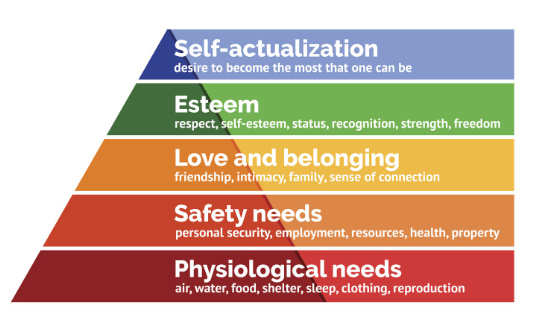
For Esker, building a human-centric and sustainable business has been the objective ever since we started the company 39 years ago. And today we still ask ourselves how we can encourage others to also embrace this vision for their organisations.
Some vacation reading took me to the Maslow Hierarchy of Needs, and this theory seemed quite fitting not just on a personal level, but also for a business. According to Maslow, what motivates humans to act is the goal of fulfilling five levels of needs: physiological, safety, social, esteem and self-actualisation. The lower-level needs must be satisfied before the higher-level needs can be pursued.

An organisation’s needs can be categorised into a similar ranking: The source-to pay (S2P) and order-to-cash (O2C) processes involve the flow of information and money between a company and its customers and suppliers. These processes are, in fact, the foundation of business operations, as they cover the entire cycle of procurement and sales: from sourcing suppliers and placing orders to delivering goods or services and collecting payments. Automating these processes improves efficiency, accuracy, speed and customer satisfaction. These advantages, in turn, flow into all business relationships, including buyers, suppliers, customers and employees.
Using the Maslow Hierarchy of Needs as a template, we can trace the five motivational levels to a business, too:
Physiological needs for humans consist of food, water, and shelter. For a business, these are cash, liquidity and solvency. Automating the S2P and O2C processes, especially with AI-powered solutions, can help a business meet these needs by making these processes faster, more efficient and accurate. This means fewer errors and delays, and lowered costs by getting paid and paying others faster. Automation can also help a business monitor and manage its cashflow better, so it always has enough money to operate and grow.
Safety needs include security, stability and protection. By improving the quality and consistency of S2P and O2C processes with automation, businesses can reduce the exposure to disruptions, disputes and fraud. Automation solutions build a reliable supply chain, ensuring compliance with rules and regulations, and mitigating risks through consistent decision-making, reliable predictions and accurate data insights.
Social needs generally describe a sense of belonging, acceptance and affiliation. At Esker, we place a lot of attention on exactly this factor: When a business takes care and ownership of the needs of others in their business ecosystem, it creates what we call positive-sum growth. It means that no business can for the long run operate at the expense of anyone or anything else, be it its employees, suppliers or the planet. Automation can help a business meet this standard by enhancing the communication and collaboration with all stakeholders. Not only does this translate into improved customer satisfaction and increased customer loyalty, but also better relationships with suppliers and stronger employee engagement.
Esteem needs refer to the feelings of being recognised, respected and having a sense of achievement. Speeding up business processes and improving their quality ensures better profitability, which gives a company a competitive edge, the ability to convey a strong performance, and engage in sustainable growth. Additionally, these outcomes will positively impact the brand image and reputation of a company, which attracts and retains more customers and talent while reassuring suppliers.
Self-actualisation needs include personal growth and the fulfilment of one’s potential. A clear vision, a strong company culture, and a focus on making a positive impact in the world will inevitably result in a business environment that creates true value to all of society. Automation can help a business meet these needs by freeing up time and resources for strategic planning, value creation, and social responsibility. Aligning the S2P and O2C processes with the company’s mission, vision and values means investing in a stronger ability to focus, inspire creativity, and perform sustainably and with agility.
Since businesses are made up of humans, it’s no wonder that these two compare so easily. And just like in those outdoor survival tv shows where the contestants first build a shelter, forage or hunt for food, and then increasingly turn their attention to improvements or artistic pursuits, an organisation should take care to cover the basics before thinking about expansion or vanity projects. Automating the S2P and O2C processes not only satisfies the basic operational requirements but also creates value and meaning for themselves and their stakeholders in a dynamic and competitive environment.
To find out more about positive-sum growth and how we integrate it into our solutions and daily life, visit www.esker.co.uk

Emmanuel Olivier
Emmanuel has been with Esker for 25 years. As WW Chief Operating Officer, he leads Esker’s operations worldwide, covering sales, marketing and consulting activities. He also supervises Esker’s finances and is in charge of its financial communication and investor relations.

